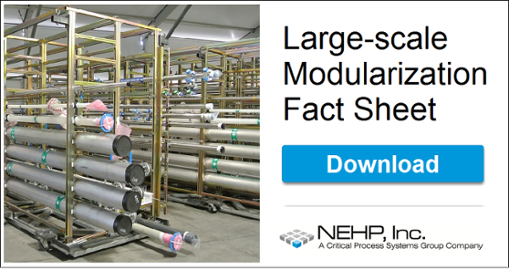Reducing Construction Risk Through Lean Integration
Construction risk can come in many forms including logistical, technical, managerial, and financial [1]. Through the adoption of Lean based principles, offsite manufacturers, contractors and owners alike have been successful in keeping common industry-related risks to a minimum.
Practicing lean established methods can maximize company efficiency, improve productivity, minimize waste, and reduce many construction risk factors for all participants and stakeholders.
There are several lean initiatives to improve and drive key business results. One of those methods is value stream mapping. VSM can be applied to individual departments or any business process that's not firing on all cylinders. I like to recommend engaging in small operational activities that need improvement first, and once the team understands the value mapping process, take on larger department initiatives.
In the image below, value stream mapping was used to analyze production bottlenecks responsible for late deliveries and inventory issues. Through this process, we were able to identify, locate and fix the issues.
/value-stream-mapping-logistical-construction-risks.jpg?width=557&name=value-stream-mapping-logistical-construction-risks.jpg)
Here we'll take a quick look at four major construction risk categories, and identify key objectives that should be incorporated and reviewed within your business models to effectively apply lean based principles against them.
LOGISTICAL RISKS
The risk of having logistical issues arise during production processes can easily compound if basic lean principles are not integrated with all team members to control any unnecessary activities. The absence of a logistical plan on a construction site and/or product manufacturing line can lead to several bottlenecks causing delays and eroded profit margins. It is critical to organize the flow of materials, resources, and equipment to achieve project financial goals.
Using VSM with a lean integrated team approach shares accountability and responsibility, which elevates everyone's incentive to avoid unnecessary activities and eliminate logistical risks before they become larger problems.
TECHNICAL RISKS
Technical risks within a construction or manufacturing process include anything that restricts you from creating the product that your customer wants or has purchased. Early alignment with all stakeholders and pre-planning for what could go wrong at the preconstruction or manufacturing phase start can minimize technical impacts that will affect your total outcome.
In addition to identifying potential shortcomings, it is equally important to share and communicate your findings so there is ownership and accountability for each of the items. Such items might include:
- uncertainty of resources and availability of materials
- inadequate site logistics for constructability
- incomplete design
- unclear processes and rules of engagement
Adapting to smarter technology tools like BIM technology, or even KPI tracking software, can help minimize and solve many of the types of technical risk that trouble our assignments.
MANAGERIAL RISKS
Another roadblock that many construction projects face is management issues. Management issues can range from a lack of upper management support to wrong personnel in leadership positions, or inadequate use of project tools and processes. By not having a complete review all project requirements, leaders are more likely to mismanage budgets and make mistakes that end up missing financial goals. With more than 90% of the world’s infrastructure projects late or over budget [2], not fully engaging in today’s lean principles will only result in becoming a similar statistic.
Integrated Project Delivery (IPD) is a full-spectrum approach that provides most of the tools necessary for managing a successful team, including full lean thinking on how to maximize value, eliminate waste, and make reliable commitments.
FINANCIAL RISKS
At the end of the day, managing financial risk is the roll-up of the three prior risk categories. Ultimately, adopting the proper available tools to manage all aspects of your project's logistical, technical, and managerial risks will positively impact your financial outcome. Again, a commitment to using lean IPD techniques is one of the best methods for reducing project inefficiencies and creating a well-oiled, organized program.
It is evident that by utilizing and committing to Lean based construction methods, all stakeholders can improve their project's efficiency to reduce the amount of waste created. There are many unknown factors in today’s projects, if we don’t continue to challenge ourselves, we won’t excel to improve our project commitments. Unfortunately, nothing happens overnight. Take baby steps to manage initiatives and expectations, as implementing lean based value is definitely a journey that requires time, patience, and continual learning.
If you would like to learn more about useful Lean methods for construction productivity improvement, please feel free to:
Visit Our Lean Construction Integration Page Here
OR
Visit Our Large-scale Modularization Page Here
Sources:
[1] https://esub.com/the-types-of-risks-in-construction-projects-to-watch-out-for/
[2] https://www.economist.com/business/2017/08/17/efficiency-eludes-the-construction-industry
[3] http://aiad8.prod.acquia-sites.com/sites/default/files/2017-02/Integrated%20Project%20Delivery%20Guide.pdf
